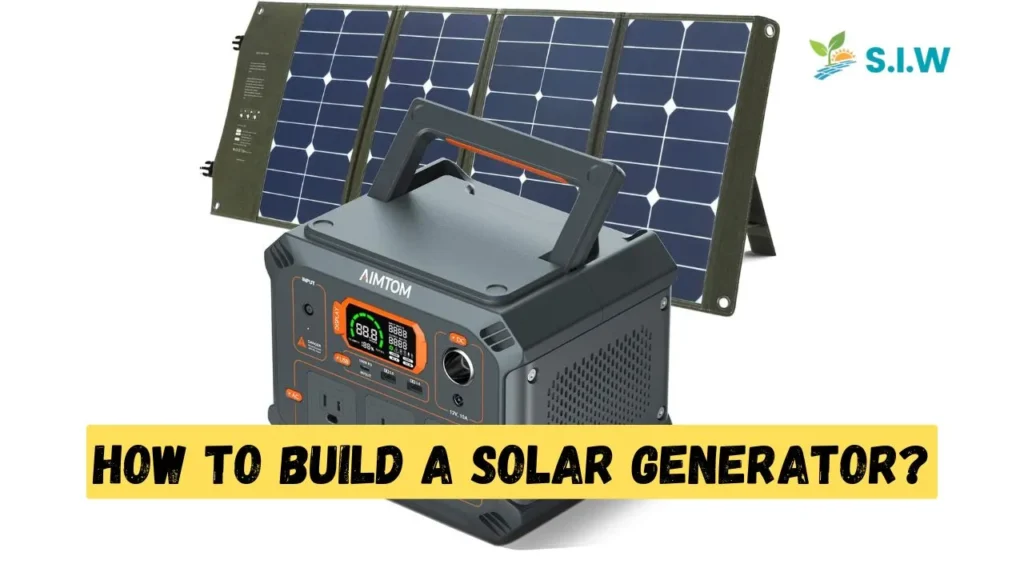What is a Solar Generator?
A solar generator is a system that converts sunlight into electricity by using solar panels, a battery for storage, and an inverter for converting the electricity into usable AC power. Unlike traditional generators, solar generators rely on renewable energy sources, making them eco-friendly and cost-efficient in the long run.
Why Build Your Own Solar Generator?
Building your own solar generator gives you the flexibility to customize it according to your needs. Whether you’re looking to power a small off-grid cabin, supply backup energy during power outages, or even create a portable power solution for camping, a DIY solar generator offers unmatched personalization and control. Plus, you can save money by purchasing components individually and assembling them yourself.
Key Components of a Solar Generator
Solar Panels
Solar panels are the backbone of any solar generator system, capturing sunlight and converting it into electrical energy. Panels come in different types, including monocrystalline and polycrystalline, with varying efficiencies. Choosing the right panels is crucial for optimal power generation.
Charge Controller
The charge controller regulates the voltage and current from the solar panels to the battery, preventing overcharging and extending the lifespan of the battery. It acts as a gatekeeper, ensuring your battery gets the right amount of power.
Battery Storage
Energy captured by the solar panels is stored in a battery for later use. The size and type of battery you choose will affect how long you can power your devices.
Inverter
An inverter is needed to convert the direct current (DC) stored in the battery into alternating current (AC), which most appliances and electronic devices use. Choosing an inverter that matches your energy needs is key to a well-functioning solar generator.
Step-by-Step Guide on How to Build a Solar Generator
Step 1: Gathering Materials
Before starting, gather all the necessary components: solar panels, a charge controller, a deep-cycle battery, an inverter, and the required cables and connectors.
Step 2: Sizing Your Solar Panels
Determining the wattage needed for your solar panels is essential. Calculate your daily energy usage and ensure your panels can produce enough power to meet your needs.
Step 3: Selecting the Right Battery
Choose a deep-cycle battery that can store the amount of energy your solar panels generate. Popular options include lead-acid and lithium-ion batteries.
Step 4: Connecting the Charge Controller
Install the charge controller between the solar panels and the battery. This ensures the proper regulation of the power flow to prevent overcharging.
Step 5: Installing the Inverter
Connect the inverter to the battery. The inverter will convert the stored DC energy into usable AC power for your home or devices.
Step 6: Assembling the System
Once all the components are connected, assemble them into a compact, portable setup. Make sure to securely mount the panels and ensure all wiring is properly insulated.
Step 7: Testing and Final Adjustments
After assembly, test the solar generator to ensure everything is functioning correctly. Check the battery charge levels, monitor the inverter’s performance, and adjust any settings as needed.
Advantages of Building Your Own Solar Generator
Cost-Effectiveness
By building a solar generator yourself, you can save a significant amount compared to buying a pre-made system. Plus, you can purchase components gradually based on your budget.
Customization for Your Needs
Whether you need a small generator for camping or a more robust system for home backup power, you can design your generator to meet your exact specifications.
Choosing the Right Solar Panels
Monocrystalline vs. Polycrystalline Panels
Monocrystalline panels are typically more efficient and space-saving, but they come at a higher price. Polycrystalline panels are more affordable but slightly less efficient.
Efficiency and Power Output
Consider the efficiency rating of the panels and their wattage output to determine how much energy they can generate for your needs.
Selecting the Best Battery for Your Solar Generator
Types of Batteries: Lead-Acid vs. Lithium-Ion
Lead-acid batteries are a cost-effective option, but they are heavier and have a shorter lifespan. Lithium-ion batteries are lighter, more efficient, and have a longer lifespan, but they are more expensive upfront.
Battery Capacity and Performance
Battery capacity, measured in amp-hours (Ah), determines how long your solar generator can provide power. Choose a battery with enough capacity to meet your energy needs.
Inverters: Essential for AC Power
How Inverters Work
Inverters convert the DC power stored in your battery into AC power, which most household appliances require. Without an inverter, you won’t be able to use your solar generator for AC devices.
Choosing the Right Inverter for Your Generator
When selecting an inverter, consider the wattage of the devices you plan to power. Ensure the inverter can handle the peak wattage requirements.
Building your own solar generator is a rewarding and practical project. By carefully selecting your components and following the steps outlined, you can create a reliable, efficient power source that meets your specific needs.
FAQs
What Are the Benefits of Using Solar Energy?
Solar energy is renewable, sustainable, and reduces reliance on fossil fuels, contributing to a cleaner environment.
How Long Does It Take to Build a Solar Generator?
Depending on your level of expertise, building a solar generator can take anywhere from a few hours to a couple of days.
Can I Use a Solar Generator for My Entire House?
For small houses or cabins, a solar generator can power essential appliances, but for larger homes, you may need a more extensive system.
What Is the Lifespan of a Solar Generator?
The lifespan depends on the quality of components, especially the battery. A well-maintained system can last over 10 years.
How Much Does It Cost to Build a Solar Generator?
Costs vary depending on the size and quality of the components, but a basic system can start around $500.
What Are the Best Locations to Set Up a Solar Generator?
Solar generators work best in locations with abundant sunlight and minimal shading.








